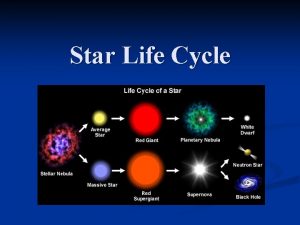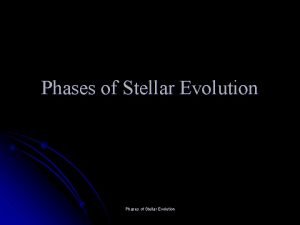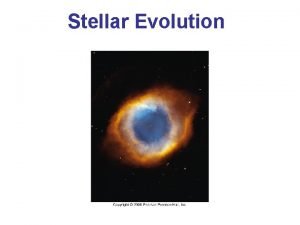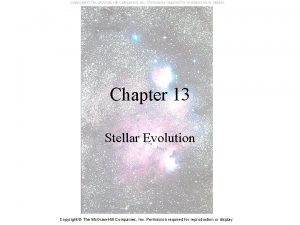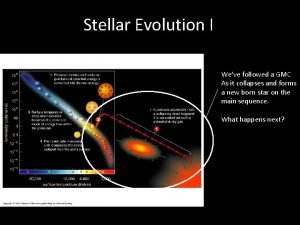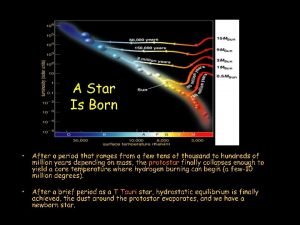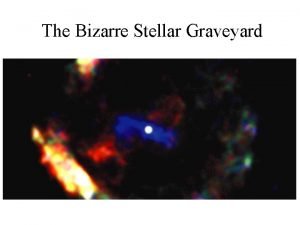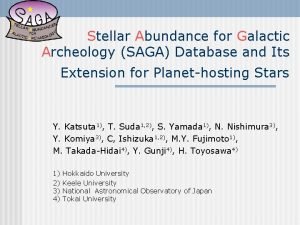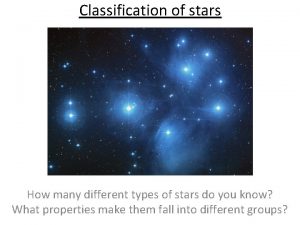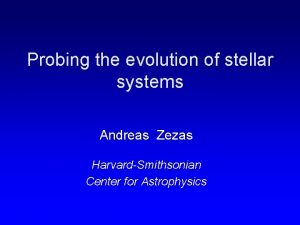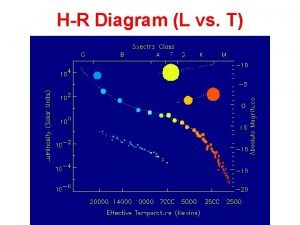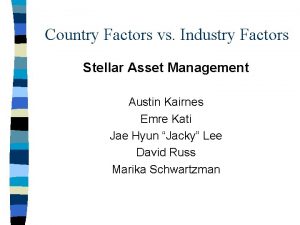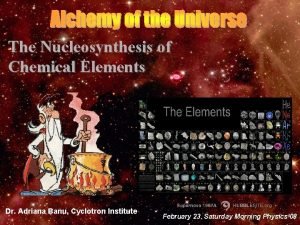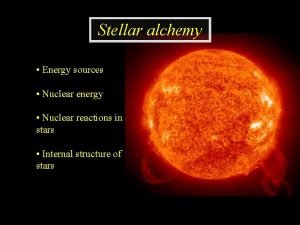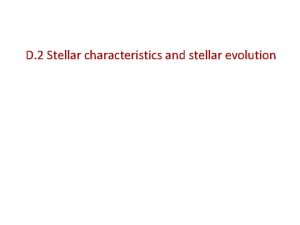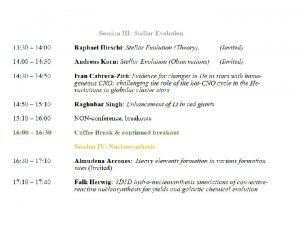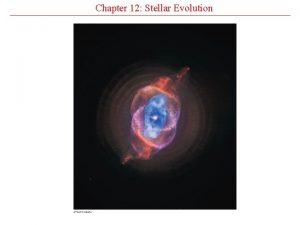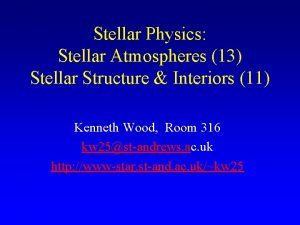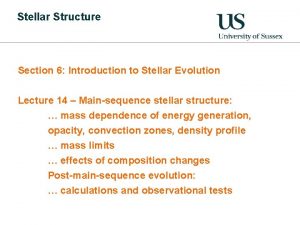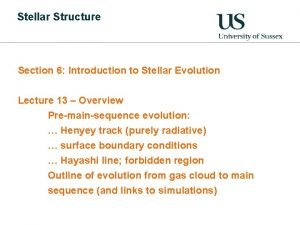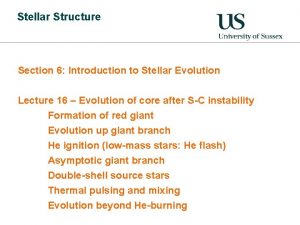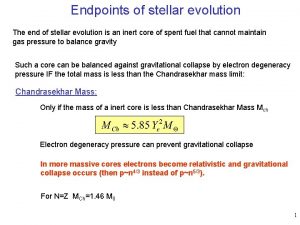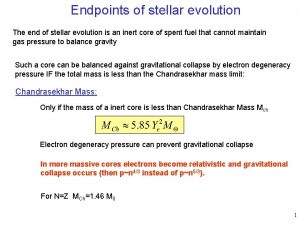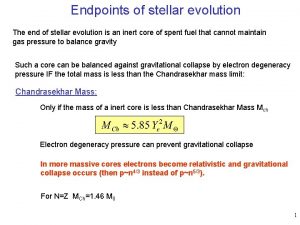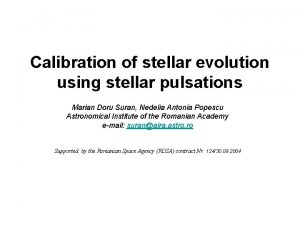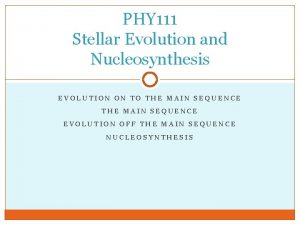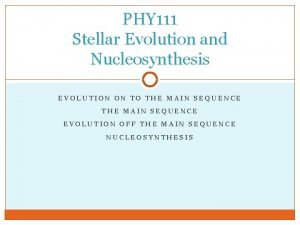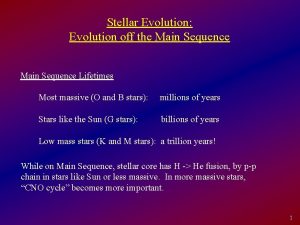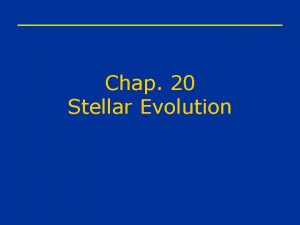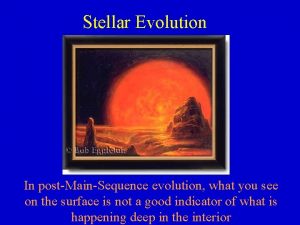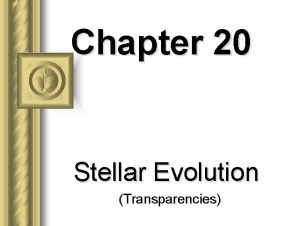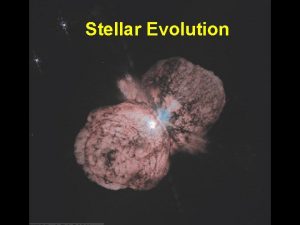D 2 Stellar characteristics and stellar evolution The






























































- Slides: 62

D. 2 Stellar characteristics and stellar evolution

• The Electromagnetic Spectrum In astronomy, we cannot perform experiments with our objects (stars, galaxies, …). The only way to investigate them, is by analyzing the light (and other radiation) which we observe from them. The study of the universe is so challenging, astronomers cannot ignore any source of information; that is why they use the entire spectrum, from gamma rays to radio waves.

Wavelength and Color • The color of light depends upon its wavelength. BLUE – HOT!!! • SHORT Wavelength • HIGH Frequency • HIGH ENERGY! RED – COLD!!! • LONG Wavelength • LOW Frequency • LOW ENERGY!

Wien's law Consequences of Wien's Law Hot objects look blue Cold objects look red lpeak T (ºK) Sun 500 nm 5800 People Neutron Star 9 x 103 nm 310 2. 9 x 10 -2 nm 108 Radio 10 m 0. 03 K Microwave 1 cm 3 K Infrared 1 mm 300 K Visible 500 nm 6000 K Ultraviolet 100 nm 100, 000 K X-Ray 0. 1 nm 10 M K The spectrum of a star/planet/object reveals it’s temperature


Hot! Cool! Through a telescope the 'star' Albireo is revealed to actually be composed of two bright stars. These stars have very different surface temperatures, as indicated by their color. Cooler stars! Hotter stars!


Where Does Light Come From? The following had been known during the 19 th century: accelerated charges emit energy and hence produce light If we picture an electron as in orbit around the nucleus, it should radiate light changing direction requires acceleration! (a force is required from something to change direction) This caused a major problem with classical physics If the electron radiated due to its motion around the nucleus, it would lose energy and soon spiral into the nucleus. The world should collapse instantly!

1913, Niels Bohr formulated 3 rules regarding atoms: 1. Electrons can only be in discrete orbits. 2. A photon can be emitted or absorbed by an atom only when an electron jumps from one orbit to another. 3. The photon energy equals the energy difference between the orbits. The discrete (quantum) nature of the energy "levels" of the electron gives Quantum Mechanics its name.

Key Features of the Atoms/Ions Spectral lines Hydrogen spectrum The greater the difference between the quantum numbers, the larger the energy of the photon emitted or absorbed. Most prominent lines in many astronomical objects: Balmer lines of hydrogen

LET ME TELL YOU AMAZING STORY OF TIME

Analyzing Absorption an Emission Spectra ● Each element (atom/ion) atom/ion produces a specific set of absorption (and emission) lines. We call this the "spectral signature" spectral signature or “fingerprints” of an atom/ion. fingerprints ● Allows the identification of elements across the galaxy and universe. (If we mapped it and can recognize it) ● Comparing the relative strengths of these sets of lines, we can study the composition of gases.

Step from line spectrum to continuous spectrum The energy levels get closer together as the quantum numbers get larger.

Key Features of the Continuum Spectra ► If an electron is given enough energy (via a photon or by other means) it can escape the atom. The electron is then "unbound" and the quantization of energy levels disappears. The energy of an electron in the continuum is not quantized. A hot, dense object contains many "loose" electrons which can emit photons of any energy. ► The light produced by a hot, dense object is called thermal emission and it contains photons of all energies, i. e. light of all colors, or wavelengths. The resulting "rainbow" is called a continuous spectrum. ► As we heat up an object, we are giving the electrons more kinetic energy, so they become able to emit more energy. The hotter the object becomes, the brighter the continuous spectrum becomes.

THERMAL RADIATION Hot, so it emits light

Peak color (wavelength) shifts to shorter wavelengths as an object is heated increasing temperature So, emitted spectrum tells us about temperature

Temperature Spectrum of Objects • All objects emit a continuous spectrum • You are giving off light right now!

If you could fill a teaspoon just with material as dense as the matter in an atomic nucleus, it would weigh ~ 2 billion tons!! just for fun – so cute Kirchoff's Laws of Spectroscopy/Radiation Kirchoff formulated these laws empirically in the mid-19 th century – didn’t explain why – in early 20 th century: QM – nature of atom – beginning of understanding origin of spectra Kirchhoff did not know about the existence of energy levels in atoms. The existence of discrete spectral lines was later explained by the Bohr model of the atom, which helped lead to Bohr model quantum mechanics

1. A hot solid, liquid or gas at high pressure produces a continuous spectrum – all λ. 2. A hot, low-density / low pressure gas produces an emission-line spectrum: energy only at specific λ. 3. A continuous spectrum source viewed through a cool, low-density gas produces an absorption-line spectrum: missing λ = dark lines. Thus when we see a spectrum we can tell what type of source we are seeing.

Absorption Spectrum of Hydrogen Gas

Actual Examples of Emission Spectra Element Spectrum Argon Helium Mercury Neon Sodium

The Spectra of Stars Inner, dense layers of a star produce a continuous (blackbody) spectrum. Cooler surface layers absorb light at specific frequencies. => Spectra of stars are absorption spectra.

What Color is Our 5800 K Sun? • The Sun emits all colors • Blue-green is most intense Peak Color (Wavelength) Depends on Object’s Temperature

Sometimes emission lines dominate the light output. The Cygnus supernova remnant emits almost all of its light as emission lines! PS. A supernova remnant is the expanding shell of hot gas left over after a star explodes.

An interesting example of a black body radiation is thermal emission of the Earth (or any other body). This thermal emission (also called infrared emission, due to its characteristic wavelength) is due to the Earth's temperature. In the picture, we can see the real emission compared to a black body radiation of a body at a temperature of 280 K. In the picture it is also possible to see the absorption spectral lines of oxygen and CO 2.

EX: (a) Explain the term black-body radiation. Black-body radiation is that emitted by a theoretical perfect emitter for a given temperature. It includes all wavelengths of electromagnetic waves from zero to infinity. The diagram is a sketch graph of the black-body radiation spectrum of a certain star. (a) Copy the graph and label its horizontal axis. (c) On your graph, sketch the black-body radiation spectrum for a star that has a lower surface temperature and lower apparent brightness than this star. The red line intensity should be consistently lower and the maximum shown shifted to a longer wavelength. (d) The star Betelgeuse in the Orion constellation emits radiation approximating to that emitted by a black-body radiator with a maximum intensity at a wavelength of 0. 97 µm. Calculate the surface temperature of Betelgeuse.

The Amazing Power of Starlight Just by analyzing the light received from a star, astronomers can retrieve information about a star’s 1. Total energy output 2. Surface temperature 3. Radius - radius 4. Chemical composition 5. Rotational and translational velocity relative to Earth 6. Rotation period

In general, the density and temperature of a star decreases with distance from its centre. Because its temperature is so high, a star’s core has to be composed of high-pressure gases and not of molten rock, unlike the cores of some planets

A caveat to the rules of thermal radiation! • Cooler objects can sometimes emit more light overall. • Decreasing temp means less light emitted per unit area. An object can compensate by being BIGGER. • Lower “surface brightness”, but larger surface area. Hot. Cool. Same total light emitted Cool, but big.

There a few stars that are more luminous than the Sun. For instance, Betelgeuse has L ~ 14000 x Lsun. There are lots more low luminosity stars than high luminosity stars. Betelgeuse ("beetle juice"), a red supergiant star about 600 light years distant - one of the brightest stars in the familiar constellation of Orion, the Hunter - the first direct picture of the surface of a star other than the Sun. While Betelgeuse is cooler than the Sun, it is more massive and over 1000 times larger. If placed at the center of our Solar System, it would extend past the orbit of Jupiter (has an immense but highly variable, outer atmosphere ). As a massive red supergiant, it is nearing the end of its life and will soon become a supernova

Cepheid variables are stars with regular variation in luminosity (rapid brightening, gradual dimming) which is caused by periodic expansion and contraction of outer surface (brighter as it expands). This is to do with the balance between the nuclear and gravitational forces within the star. In most stars these forces are balanced over long periods but in Cepheid variables they seem to take turns, a bit like a mass bouncing up and down on a spring. Because they are so luminous it means that very distant Cepheids can be observed from the Earth. In 1784, the periodic pulsation of the supergiant star, Delta Cephei, was discovered by the English amateur astronomer, John Goodricke. This star has a period of about 5. 4 days In 1908, the American astronomer, Henrietta Leavitt working at the Harvard College Observatory compiled a list of 1, 777 periodic variables in the Large and Small Magellanic Cloud. Eventually she classified 47 of these in the two clouds as Cepheid variables published an article describing the linear relationship between the luminosity and period of pulsation. Her plot showed what is now known as the periodluminosity relationship: Cepheids with longer periods are intrinsically more luminous than those with shorter periods.

It is now known that there are many more of these variable stars – collectively known as Cepheids. The period of these stars varies between twelve hours and a hundred days. Cepheid variable stars are known as “standard candles” because they allow us to standard candles measure the distances to the galaxies containing Cepheid variable stars.

Cepheid stars are stars that have completed the hydrogen burning phase and moved off the main sequence (see later for an explanation of this). The variation in luminosity occurs because the outer layers within the star expand contract periodically. This is shown diagrammatically as: (1) a layer loses hydrostatic equilibrium and is pulled inwards by gravity (2) the layer becomes compressed and less transparent to radiation (3) temperature inside the layer increases, building up the internal pressure (4) causing the layer to be pushed outwards (5) During expansion the layer cools, becoming less dense (6) and more transparent, allowing radiation to escape and letting the pressure inside fall (1) Subsequently the layer falls inwards under gravity and the cycle repeats causing the pulsation of the radiation emitted by the star.

EX: (a) Define (i) luminosity (ii) apparent brightness. (i) Luminosity is the total power radiated by star. (ii) Apparent brightness is the power from a star received by an observer on the Earth per unit area of the observer’s instrument of observation. (b) State the mechanism for the variation in the luminosity of the Cepheid variable. Outer layers of the star expand contract periodically due to interactions of the elements in a layer with the radiation emitted. The variation with time t, of the apparent brightness b, of a Cepheid variable is shown below. Two points in the cycle of the star have been marked A and B. (c) (i) Assuming that the surface temperature of the star stays constant, deduce whether the star has a larger radius after two days or after six days. (i) The radius is larger after two days (point A) because, at this time the luminosity is higher and so the star’s surface area is larger.

(ii) Explain the importance of Cepheid variables for estimating distances to galaxies. Cepheid variables show a regular relationship between period of variation of the luminosity and the luminosity. By measuring the period the luminosity can be calculated and, by using the equation b = L/4πd 2 , the distances to the galaxy can be measured. This assumes that the galaxy contains the Cepheid star. (d) (i) The maximum luminosity of this Cepheid variable is 7. 2 × 1029 W. Use data from the graph to determine the distance of the Cepheid variable. (ii) Cepheids are sometimes referred to as “standard candles”. Explain what is meant by this. A standard candle is a light source of known luminosity. Measuring the period of a Cepheid allows its luminosity to be estimated. From this, other stars in the same galaxy can be compared to this known luminosity.

Let’s review some important things we want to know about stars… Given enough time and information, we can figure out their… • Brightness - easily observed • Parallax to measure distance • Spectral type - can get from the spectrum • Brightness + Distance = Luminosity • Temperature - can get from spectrum • Temperature + distance = Size • Mass - hard to figure out, but there are binary stars • Age - exact age is hard, but can estimate

What do you do when you have data and you don’t know what to do with it and you don’t understand it? CLASSIFY! HOPE: We just might get to know THE universe better?

Stars can be arranged into categories based on the features in their spectra… This is called “Spectral Classification” How do we categorize stars? A few options: 1. 2. 3. by the “strength” (depth) of the absorption lines in their spectra by their color as determined by their blackbody curve by their temperature and luminosity

• Much of the work in classifying and explaining stellar spectra and brightness was done by women at Harvard around the turn of the century. Harvard Computers (1890)

Annie Jump Cannon (1863 -1941) • Single-handedly classified more than 250, 000 stellar spectra. Henrietta Leavitt (1868 -1921) Stars are classified by their spectra as O, B, A, F, G, K, and M spectral types

• OBAFGKM • hottest to coolest • bluish to reddish • An important sequence to remember: – Oh Boy, An F Grade Kills Me

The Spectral Sequence Class Spectrum Color Temperature O ionized and neutral helium, weakened hydrogen bluish 31, 000 -49, 000 K B A F neutral helium, stronger hydrogen blue-white 10, 000 -31, 000 K strong hydrogen, ionized metals white 7400 -10, 000 K weaker hydrogen, ionized metals yellowish white 6000 -7400 K G still weaker hydrogen, ionized and neutral metals yellowish 5300 -6000 K K weak hydrogen, neutral metals orange 3900 -5300 K M little or no hydrogen, neutral metals, molecules reddish 2200 -3900 K

Eventually, the connection was made between the observables and theory. Observable: • Strength of Hydrogen Absorption Lines • Blackbody Curve (Color) Cecilia Payne Theoretical: • Using observables to determine things we can’t measure: Temperature and Luminosity

Categorizing the stars… Hertzsprung-Russell (H-R ) Diagram In the early 1900 s, two astronomers, Ejnar Hertzsprung in Denmark and Henry Norris Russell in America, independently devised a pictorial way of illustrating the different types of star. • graph of luminosity versus temperature (or spectral class) Henry Norris Russell dissuaded Cecilia Payne-Gaposchkin from concluding that the composition of the Sun is different from that of the Earth in her papers, as it contradicted the accepted wisdom at the time. However, he changed his mind four years later after deriving the same result by different means. After Payne was proven correct, Russell briefly credited Payne for discovering that the Sun had a different chemical composition from Earth in his paper. However the credit was still generally given to him instead. [11]

Shematic H-R Diagram O B A F G K M 104 L/LΘ BRIGHT SUPER GIANTS 106 MA IN GIANTS SE QU 102 EN WH DW ITE AR FS 10 -2 CE FAINT 10 -4 40, 000 20, 000 10, 000 5, 000 2, 500 Temperature HOT COOL

the stars aren’t randomly scattered on this graph-- they form a line!Same WHAT IS AMAZING: Stars of different masses fall along a narrow path temperature, in L/T diagram but much brighter than MS stars → Must be M os much larger t s. Stt ac aarrs t. M ive asrp ai li een n Se fe. S eti fodu m qu qmue ndos en e on atl o ce nc th onf th (M e e g ei Sam Ma thr fain e temp S). in e ter. , b → Dw ut arfs ► Giant Stars “Red Giants” “Supergiants” None of these “extra” stars are Hydrogen burning!

If a random star falls on the Main Sequence, you also know that it’s Hydrogen burning! Nearly 90% of all stars fit into this category. If you measure the luminosity and the color of a star, you know its mass!!!

The more massive a star is, the more luminous it is… But a higher rate of fusion means it’s burning its fuel faster! More massive stars are… • • Low mass stars have lifetimes comparable to the Age of the Universe High mass stars have very short lifetimes, and disappear quickly! Hotter Brighter Bigger Shorter-lived

The high mass stars are gone! After time passes… Only long-lived low mass stars are left on the main sequence!

Red Giants: • Cool, but bright. • Same temp as some main sequence stars same surface brightness! Must be bigger AREA BIGGER star! (and thus the name, red giant) Red giants are cooler than the Sun and so emit less energy per square metre of surface. However, they have a higher luminosity, emitting up to 100 times more

The Mystery of Red Giants and White Dwarfs… Many of these stars have the same temperature as normal Main Sequence stars, but they’re much brighter or fainter! brighter How is this possible? ? ? Same Temperature & Surface Brightness Hot. Cool. Same Luminosity Cool, but big Luminous! Hot, but tiny Faint. If the size of the star changes, size L = b x Area its luminosity changes luminosity

The Hertzsprung–Russell (H – R) diagram is a scattergram of stars showing the relationship between the stars' luminosities versus their surface temperature. It shows stars of different ages and in different temperature stages, all at the same time. Vertical axis: luminosity/ luminosity of the Sun (L⊙= 3. 839 × 1026 W). Axis is logarithmic and has no unit. The temperature axis is also logarithmic and doubles with every division from right (low) to left (high). main sequence stars: nearly 90% of all stars main sequence stars ▪ fusing hydrogen into helium, the difference between them is in mass ▪ during the lifetime of a star its position will move on the diagram as its temperature and luminosity changes ▪ left upper corner more massive than right lower corner ▪ cooler red stars relatively low luminosity; ▪ hotter blue stars: high luminosity. Red giants are cooler than the Sun • emit less energy/m 2 of surface. • higher luminosity means they have a much greater surface area. White dwarfs • a much larger diameter than the Sun – “giant” stars. • remnants of old stars Supergiant stars are gigantic and very bright. stars • constitute about 9%of all stars • A supergiant has 100 000 times the power and • energy not produced by nuclear fusion at the same temperature of the Sun must have • very hot when they stopped producing energy, a surface area 100 000 times larger: a diameter that • they have a relatively low luminosity is over 300 times the diameter of the Sun. • a small surface area. • Only about 1%of stars are giants and supergiants. • very small, hot, very dense stars • take billions of years to cool down.

• Relationship between the luminosity and the mass: L ∝ M 3. 5 (Observations of thousands of main sequence stars) L is the luminosity in W (or multiples of the Sun’s luminosity, L ⊙ ) M is the mass in kg (or multiples of the Sun’s mass, M ⊙ ). • Even a slight difference in the masses of stars results in a large difference in their luminosities. • For a star to be stable it needs to be in hydrostatic equilibrium: the pressure due to the gravitational attraction of inner shells = thermal and radiation pressure acting outwards. For a stable star of higher mass there will be greater gravitational compression and so the core temperature will be higher. Higher temperatures make the fusion between nuclei in the core more probable giving a greater rate of nuclear reaction and emission of more energy; thus increasing the luminosity. • The mass of a star is fundamental to the star’s lifetime – High mass stars have shorter lifetimes. – a star with a mass of 10 times the solar mass might only live 10 million years compared to the expected lifetime of around 10 billion years for the Sun.

Stellar evolution Formation of a star ▪ Gravitational attraction of hydrogen nuclei. ▪ Loss of PE leads to gain in KE and an increase in the gas temperature. ▪ The gas becomes denser and, when the protostar has sufficient mass, the temperature becomes high enough for nuclear fusion to commence. ▪ The star moves onto the main sequence where it remains for as long as its hydrogen is being fused into helium – this time occupies most of a star’s life. ▪ Eventually when most the hydrogen in the core has fused into helium the star moves off the main sequence. The fate of stars ▪ Star collapses when most of the hydrogen nuclei have fused into helium. ▪ Gravity now outweighs the radiation pressure and the star shrinks in size and heats up. ▪ The hydrogen in the layer surrounding the shrunken core is now able to fuse, raising the temperature of the outer layers which makes them expand, forming a giant star. ▪ Fusion of the hydrogen adds more helium to the core which continues to shrink and heat up, forming heavier elements including carbon and oxygen. ▪ The very massive stars will continue to undergo fusion until iron and nickel (the most stable elements) are formed. ▪ What happens at this stage depends on the mass of the star.

A. Sun-like stars ▪ For stars up to about 4 solar masses the core temperature will not be high enough to allow the fusion of carbon. This means that, when the helium is used up, the core will continue to shrink while still emitting radiation. ▪ This “blows away” outer layers forming a planetary nebula around the star. When the remnant of the core has shrunk to about the size of the Earth it consists of carbon and oxygen ions surrounded by free electrons. ▪ It is prevented from further shrinking by an electron degeneracy pressure. Pauli’s exclusion principle electron degeneracy pressure prevents two electrons from being in the same quantum state and this means that the electrons provide a repulsive force that prevents gravity from further collapsing the star. The star is left to cool over billions of years as a white dwarf 9 Such stars are of very high density of about 10 kg m– 3. The probable future for the Sun is shown as the purple line on the HR diagram.

B. Larger stars ▪ For the star much bigger than the Sun when in the red giant phase, the core is so large that the resulting high temperature causes the fusion of nuclei to create elements heavier than carbon. ▪ The giant phase ends with the star having layers of elements with proton numbers that decrease from the core to the outside (much like layers in an onion). ▪ The dense core causes gravitational contraction which, as for lighter stars, is opposed by electron degeneracy pressure. Even with this pressure, massive stars cannot stabilize. ▪The Chandrasekhar limit is the maximum mass of a stable white dwarf. It is 1. 4 times the mass of the Sun. ▪ When the mass of the core reaches this value the electrons combine with protons to form neutrons – emitting neutrinos in the process. The star collapses with neutrons coming as close to each other as in a nucleus. ▪ The outer layers of the star rush in towards the core but bounce off it in a huge explosion – a supernova. ▪ Although this process lasts just a few hours it results in the heavy elements being formed. ▪ This blows off the outer layers and leaves the remnant core as a neutron star. ▪ Now neutrons provide a neutron degeneracy pressure that resists further gravitational collapse. ▪ The Oppenheimer–Volkoff limit places an upper value on a neutron star for which neutron degeneracy is able to resist further collapse into a black hole. This value is currently estimated at between 1. 5 and 3 solar masses. PBS: There is a thin line between a bang and a whimper. For stars, this line is called the Chandrasekhar Limit, and it is the difference between dying in a blaze of glory and going out in a slow fade to black. For our universe, this line means much more: Only by exceeding it can stars sow the seeds of life throughout the cosmos.

Supernova 1987 A with the right hand image the region of the sky taken just before the event Black holes Here we discuss their importance in astrophysics. It is not possible to form a neutron star having a mass greater than the Oppenheimer–Volkoff limit instead the remnant of a supernova forms a black hole. Nothing can escape from a black hole – including the fastest known particles, photons. For this reason it is impossible to see a black hole directly but their existence can be strongly inferred by the following. ● The X-rays emitted by matter spiralling towards the edge of a black hole and heating up. X-ray space telescopes, such as NASA’s Chandra, have observed such characteristic radiation. ● Giant jets of matter have been observed to be emitted by the cores of some galaxies. It is suggested that only spinning black holes are sufficiently powerful to produce such jets. ● The unimaginably strong gravitational fields have been seen to influence stars in the vicinity, causing them to effectively spiral. A black hole has been detected in the centre of the Milky Way and it has been suggested that there is a black hole at the centre of every galaxy.

EX: A partially completed Hertsprung–Russell (HR) diagram is shown below. The line indicates the evolutionary path of the Sun from its present position, S, to its final position, F. An intermediate stage in the Sun’s evolution is labelled by I. (a) State the condition for the Sun to move from position S. Most of the Sun’s hydrogen has fused into helium. (b) State and explain the change in the luminosity of the Sun that occurs between positions S and I. Both the luminosity and the surface area increase as the Sun moves from S to I. (c) Explain, by reference to the Chandrasekhar limit, why the final stage of the evolutionary path of the Sun is at F. White dwarfs are found in region F of the HR diagram. Main sequence stars that end up with a mass under the Chandrasekhar limit of 1. 4 solar masses will become white dwarfs. (d) On the diagram, draw the evolutionary path of a main sequence star that has a mass of 30 solar masses. The path must start on the main sequence above the Sun. This should lead to the super red giant region above I and either stop there or curve downwards towards and below white dwarf in the region between F and S.

First, there was a nebula. The birth of stars in the M 16 Eagle Nebula Last, there was a nebula.

Hydrogen and helium account for nearly all the nuclear matter in today's universe. The abundance of hydrogen by mass, is 73% (Helium is 25%, All other elements 2%). By atomic abundance, hydrogen is 90%, helium 9%, and all other elements 1%. That is, hydrogen is the major constituent of the universe. As we are already talking about hydrogen let me mention one very interesting fact. I call it: a WOW story of time!!!!!! spin-flip transition even though the atom is in its ground state When a proton captures an electron to form hydrogen atom (after Big Bang) the spins of the two particles either point in the same direction or opposite direction. Due to the spin both electrons and protons behave like little magnets. Hydrogen atom with antiparallel spins is more stable (the electron is more tightly bound to the proton) than the atom with the two spins parallel because unlike poles attract each other and like poles repel. Since a anti-parallel-spin capture is three times as probable as an parallel-spin capture, 75% hydrogen atoms in between the stars is with spins anti-parallel and 25% with parallel-spin.

This means that the electron in the hydrogen atom with its spin parallel to that of the proton will ultimately flip over so that its spin is anti-parallel to the proton spin emitting 21 -cm photon (radio part of the spectrum). We should not ordinarily expect to receive much 21 -cm radiation because it takes on the average about 11, 000 years for an electron in an unmolested years hydrogen atom to flip over to an anti-parallel spin position. But there are so many such atoms in interstellar space that the occasional emission of a 21 -cm photon from any one of them adds up to the observed intensity of the 21 -cm line. The collisions among the neutral hydrogen atoms that occur every few hundred years keep the number of hydrogen atoms with parallel and antiparallel electrons spins constant or in thermal equilibrium. This hydrogen radio line with a wavelength of 21 cm was first predicted theoretically in 1944 by the Dutch astronomer H. C. van de Hulst (highly unlikely to be seen in a laboratory on Earth). It was observed in radio telescopes at Harvard and then throughout the world in the early 1950 s.

Most of what is known about the distribution of cold gas in the Galaxy, including the mapping of the nearby spiral arms, has come from detailed studies of the variation of 21 -cm line of Hydrogen emission across the sky. Stars radiate all freq. but visible light won't penetrate the dust clouds and this 21 cm will, giving us informations From the data that have now been collected, we know that the dust in interstellar space, which constitutes only about 1% of the interstellar material, is almost entirely responsible for the dimming of the stars. The size of a dust grain is about 0. 000001 cm (about the size of the wavelength of visible light) and only one such grain, on the average, is present in each 10, 000, 000 cm 3 of space. Reading the intensity of 21 cm hydrogen line from different parts of Universe we can get a fairly reliable picture of the distribution of gas (hydrogen) and dust throughout the galaxy. Take me home
 Stages of stellar evolution of a low-mass star
Stages of stellar evolution of a low-mass star Stellar evolution diagram
Stellar evolution diagram Life cycle of stars poster
Life cycle of stars poster Stellar evolution
Stellar evolution Stellar evolution
Stellar evolution Stellar evolution
Stellar evolution Hr diagram
Hr diagram Characteristics of money
Characteristics of money Atmospheric heaven
Atmospheric heaven Astronomy
Astronomy Stellar motion matlab
Stellar motion matlab Virgo stellar
Virgo stellar Masses in the stellar graveyard
Masses in the stellar graveyard Stellar hosting iptv
Stellar hosting iptv Stellar assessment
Stellar assessment Stellar saga
Stellar saga What is stellar parallax?
What is stellar parallax? Stellar
Stellar Stellar formation
Stellar formation Stellar asset management
Stellar asset management Becquerel
Becquerel Stellar wifi
Stellar wifi Stellar alchemy
Stellar alchemy Hình ảnh bộ gõ cơ thể búng tay
Hình ảnh bộ gõ cơ thể búng tay Frameset trong html5
Frameset trong html5 Bổ thể
Bổ thể Tỉ lệ cơ thể trẻ em
Tỉ lệ cơ thể trẻ em Voi kéo gỗ như thế nào
Voi kéo gỗ như thế nào Tư thế worm breton
Tư thế worm breton Chúa yêu trần thế alleluia
Chúa yêu trần thế alleluia Môn thể thao bắt đầu bằng chữ đua
Môn thể thao bắt đầu bằng chữ đua Thế nào là hệ số cao nhất
Thế nào là hệ số cao nhất Các châu lục và đại dương trên thế giới
Các châu lục và đại dương trên thế giới Công thức tính độ biến thiên đông lượng
Công thức tính độ biến thiên đông lượng Trời xanh đây là của chúng ta thể thơ
Trời xanh đây là của chúng ta thể thơ Mật thư anh em như thể tay chân
Mật thư anh em như thể tay chân Phép trừ bù
Phép trừ bù Phản ứng thế ankan
Phản ứng thế ankan Các châu lục và đại dương trên thế giới
Các châu lục và đại dương trên thế giới Thể thơ truyền thống
Thể thơ truyền thống Quá trình desamine hóa có thể tạo ra
Quá trình desamine hóa có thể tạo ra Một số thể thơ truyền thống
Một số thể thơ truyền thống Bàn tay mà dây bẩn
Bàn tay mà dây bẩn Vẽ hình chiếu vuông góc của vật thể sau
Vẽ hình chiếu vuông góc của vật thể sau Nguyên nhân của sự mỏi cơ sinh 8
Nguyên nhân của sự mỏi cơ sinh 8 đặc điểm cơ thể của người tối cổ
đặc điểm cơ thể của người tối cổ Giọng cùng tên là
Giọng cùng tên là Vẽ hình chiếu đứng bằng cạnh của vật thể
Vẽ hình chiếu đứng bằng cạnh của vật thể Tia chieu sa te
Tia chieu sa te Thẻ vin
Thẻ vin đại từ thay thế
đại từ thay thế điện thế nghỉ
điện thế nghỉ Tư thế ngồi viết
Tư thế ngồi viết Diễn thế sinh thái là
Diễn thế sinh thái là Dot
Dot Bảng số nguyên tố
Bảng số nguyên tố Tư thế ngồi viết
Tư thế ngồi viết Lời thề hippocrates
Lời thề hippocrates Thiếu nhi thế giới liên hoan
Thiếu nhi thế giới liên hoan ưu thế lai là gì
ưu thế lai là gì Hổ sinh sản vào mùa nào
Hổ sinh sản vào mùa nào Sự nuôi và dạy con của hươu
Sự nuôi và dạy con của hươu Sơ đồ cơ thể người
Sơ đồ cơ thể người
